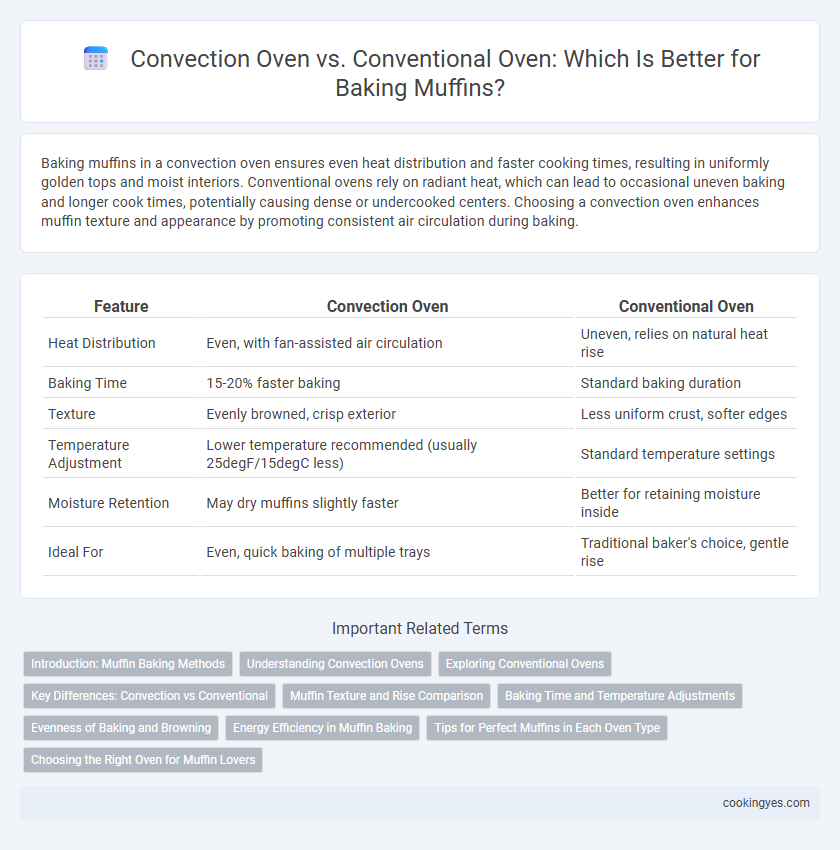Baking muffins in a convection oven ensures even heat distribution and faster cooking times, resulting in uniformly golden tops and moist interiors. Conventional ovens rely on radiant heat, which can lead to occasional uneven baking and longer cook times, potentially causing dense or undercooked centers. Choosing a convection oven enhances muffin texture and appearance by promoting consistent air circulation during baking.
Table of Comparison
| Feature | Convection Oven | Conventional Oven |
|---|---|---|
| Heat Distribution | Even, with fan-assisted air circulation | Uneven, relies on natural heat rise |
| Baking Time | 15-20% faster baking | Standard baking duration |
| Texture | Evenly browned, crisp exterior | Less uniform crust, softer edges |
| Temperature Adjustment | Lower temperature recommended (usually 25degF/15degC less) | Standard temperature settings |
| Moisture Retention | May dry muffins slightly faster | Better for retaining moisture inside |
| Ideal For | Even, quick baking of multiple trays | Traditional baker's choice, gentle rise |
Introduction: Muffin Baking Methods
Convection ovens circulate hot air using a fan, promoting even heat distribution for consistent muffin rising and uniform browning. Conventional ovens rely on static heat, which may create hotspots leading to uneven muffin texture and color. Selecting the right oven affects muffin crumb structure, moisture retention, and baking time efficiency.
Understanding Convection Ovens
Convection ovens use a fan to circulate hot air evenly, resulting in consistent heat distribution that helps muffins bake more uniformly and develop a golden crust. This air circulation reduces baking times and prevents hotspots commonly found in conventional ovens, which rely on radiant heat from top and bottom elements. Understanding convection technology allows bakers to adjust temperature settings and baking duration to achieve perfectly risen, moist muffins with a tender crumb.
Exploring Conventional Ovens
Conventional ovens bake muffins by using stationary heat, which promotes even rising and a tender crumb texture ideal for classic muffin recipes. The steady heat distribution in conventional ovens helps prevent rapid browning and ensures a consistent bake throughout the muffin batter. Many bakers prefer conventional ovens for their reliable temperature stability and ability to produce moist interiors with lightly browned crusts.
Key Differences: Convection vs Conventional
Convection ovens circulate hot air evenly with a fan, promoting faster and more uniform muffin baking compared to conventional ovens, which rely on radiant heat and may cause uneven rising or browning. This consistent air flow in convection baking helps achieve a crisp muffin crust and moist interior, while conventional ovens often require longer baking times and rotating trays for even heat exposure. Choosing between convection and conventional ovens depends on prioritizing baking speed and texture precision versus traditional baking methods.
Muffin Texture and Rise Comparison
Convection ovens promote even heat distribution and consistent air circulation, resulting in muffins with a more uniform rise and a slightly crispier exterior, enhancing texture. Conventional ovens often create a gentler heat environment, which can produce muffins with a softer crumb but sometimes less even rising and denser texture. For optimal muffin texture and rise, convection ovens tend to yield lighter, fluffier results due to efficient heat and moisture management.
Baking Time and Temperature Adjustments
Convection ovens reduce baking time for muffins by circulating hot air evenly, allowing them to bake at temperatures approximately 25degF lower than conventional ovens. This airflow promotes uniform heat distribution, resulting in faster, more consistent muffin rising and browning. Adjusting baking time typically involves a 25% reduction compared to the recommended duration for conventional ovens to prevent overbaking.
Evenness of Baking and Browning
Convection ovens promote more even baking of muffins by circulating hot air around the batter, resulting in consistent heat distribution that prevents uneven rising and soggy spots. Conventional ovens rely on radiant heat from the bottom and top, which can cause hotter and cooler areas, leading to irregular muffin textures and uneven browning. Muffins baked in convection ovens often achieve a more uniform golden-brown crust, enhancing both appearance and flavor compared to those baked in conventional ovens.
Energy Efficiency in Muffin Baking
Convection ovens use a fan to circulate hot air, resulting in faster and more even muffin baking compared to conventional ovens, which rely on radiant heat. This enhanced airflow in convection ovens reduces baking time and lowers overall energy consumption, making them more energy-efficient for muffin baking. Conventional ovens typically require longer preheating and baking periods, leading to higher energy usage and less efficient heat distribution.
Tips for Perfect Muffins in Each Oven Type
Convection ovens circulate hot air for even muffin baking, resulting in a crispier exterior and faster cooking time, so reduce the temperature by 25degF and check for doneness early. Conventional ovens provide gentler, ambient heat that helps muffins rise tall and evenly, making it ideal to bake at the recipe's suggested temperature without reducing heat. Use room temperature ingredients, avoid overmixing the batter, and rotate the muffin tray halfway through baking in both oven types for consistently tender and moist muffins.
Choosing the Right Oven for Muffin Lovers
Convection ovens offer even heat distribution and faster baking times, resulting in uniformly golden, moist muffins with a tender crumb. Conventional ovens provide gentle, consistent heat ideal for traditional muffin recipes that require slower rising and a soft texture. Muffin lovers should select convection ovens for crispier tops and quicker results, while conventional ovens suit those preferring classic, fluffy muffins.
Convection oven vs Conventional oven for muffin baking Infographic

 cookingyes.com
cookingyes.com